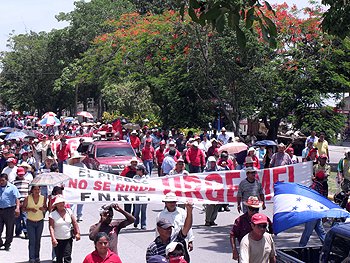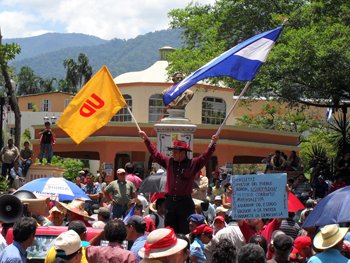


Reflections on Peaceful Protest and Constitutional Dialogue in San Pedro Sula, Honduras
Listening to the Aspirations of the Honduran People
By David Maxted
Special to The Narco News Bulletin
August 29, 2009
I recently visited Honduras for a week, having been frustrated by the absence of news coverage of the political crisis and the mass protests taking place, to try to understand what Hondurans believed about their government’s actions and about what should happen going forward. What I found astounded me: I saw an engaged citizenry of people deeply concerned about their government’s actions, taking part in a meaningful dialogue about their constitution, and about the future of their country, through peaceful, vigorous protest.
 Photos D.R. 2009 David Maxted |
Slogans were chanted, firecrackers were set off, and a fair portion of downtown San Pedro was shut down by the march, which appeared well organized, focused, and very energetic. As leaders announced call and response chants from loudspeakers, the most frequent refrain was: ”Adelante, adelante, que la lucha es constante!”, ”Forward, forward, so the fight continues!” But despite the fighting words, and the omnipresence of Ché´s battle worn image, the protest was peaceful, and the political demand clear.
Having been there and spoken with many participants and other people in San Pedro, I feel comfortable saying that, contrary to what can be gleaned by most news outlets, the protesters who support Zelaya and the referendum do not simply want to create disorder—they want to peacefully express their political views in seeking a peaceful resolution to the crisis. These protesters are not people paid by Hugo Chavez (or anyone else), and are certainly not necessarily “socialists” in the strong sense of the word—they are simply the workers, teachers, laborers, farmers, lawyers, and many others of Honduras who believe their president was illegally removed, and who wish to express this belief through collective action. There may be legitimate disagreement about the legality of what happened with Zelaya´s removal, and about the best course of action going forward, but to the disinterested observer it is clear that these protests are simply collective action to express cogent, legitimate political demands. They are Hondurans expressing views about their government, and about their constitution.
 |
As a result, the political demand of the protest is simple: reinstate Zelaya as the legitimate president and permit the constitutional referendum. To that end, the two major themes expressed by the marchers was the desire to protest peacefully, and the desire to have their human rights respected. Although 99.9 percent of the protesters simply marched and chanted, as they passed establishments viewed as anti-Zelaya, or as “Golpista” coup supporters, several young men would spray-paint political slogans and set off loud firecrackers—but appeared to pass by businesses and buildings that they did not believe were backing the coup. Although this may be vandalism and a form of property damage, it is not violence, and can be understood as part of the political speech being expressed that day. The most important point, though, is that save for this handful of youths, no one took part in property damage, and no one, absolutely no one engaged in violence—including the youths, and including the police officers on this occasion. When altercations arose between the protesters and people observing, the marchers and their leaders repeatedly, continually emphasized that the march was “pacifica”, a peaceful march, and I saw not a single incidence of violence throughout the day.
In addition to the emphasis on peaceful protest, the second refrain of the march was one of human rights, and the need for the Honduran government to respect them. As I spoke with people, they continually spoke of ”derechos humanos,” human rights, and described their action as the human right to collectively express their political beliefs. Frequently, the language of human rights was tied to a discourse about their constitution, about Zelaya as the first president of the poor, and about their desire to change the constitution to benefit the poor. That is, they believe that the referendum Zelaya hoped to call was a legitimate way to change the constitution, and supported his effort to do so.
 |
Given scant coverage of their protests that they believe often misconstrues the events, the popular media is also viewed by the protesters as a source of repression. They feel that their views are not represented by the major media outlets, which are controlled by people who supported the president’s removal. As a result, they take to the streets in the hope that direct expression will reach their fellow Hondurans, as well as the world.
To that end, as I walked through and among the march and spoke with so many people, I felt the necessity to try and communicate what I had seen, to try and counter the misinformation that has dominated Honduran and world news. I felt, and continue to feel, that the protests exemplify a stirring, healthy constitutional dialogue: a group of citizens are peacefully expressing their views about what their government is doing, about the human rights that they demand must be respected, and continually linking this to their constitution and the future of their country. The leaders of the protest at one point stopped their protesting, and directed their attention to me. Over the loudspeaker, they told everyone about the American “gringo” in the presence who had been running around, talking to people and taking pictures, and how he was going to spread the news about what they were doing to the world. I tried the New York Times with the story, but never heard back. So here is my best attempt at spreading a bit of information, and a few pictures, from a group of loud, determined, peaceful people in Honduras who hope their government, and the world, can hear them.
- The Fund for Authentic Journalism
For more Narco News, click here.




